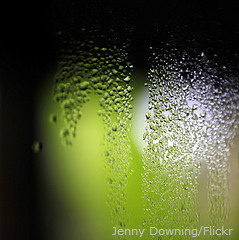Humidity is necessary for comfort in your home, but if there is too much humidity, it can cause mildew and mold. Humidity can cause condensation, wet stains on the walls and ceilings and exacerbate allergy problems -- and if you've just moved, this is the last thing you want to deal with in the midst of settling in.
Before humidity does cause problems, learn how to prepare your home for humid conditions with these tips.
Where does it come from?
Humidity is the water vapor or moisture in the air and can be created through a number of ways, including bathing and washing clothes. It can also enter your home through your crawlspace, basement or the dirt and soil surrounding your home through seepage. If you wait too long to deal with a humidity problem, it could cause issues.
Exhaust fans
Installing exhaust fans is one of the easiest ways to remove moisture and humidity in your home.
Exhaust fans should be installed in your bathrooms, laundry room, kitchen and any other rooms that have a lot of dampness in the air. They will remove the moisture from the air and make it more bearable and comfortable. For best results, turn them on and let them run for as long as you're running water in the room.
Dehumidifiers
A dehumidifier is similar to an air conditioner because it draws in the humid air and channels it over cold coils to condense and remove the moisture from the air. The moisture collects in a container and needs to be emptied as it fills up.
When choosing a dehumidifier keep these things in mind:
- The area you wish to dehumidify in square feet
- The method you wish to remove the collected water
Dehumidifiers are rated in pints removal capacity for every 24 hours, so be sure to choose the right capacity for your room and needs.
Storm windows
Installing good quality storm windows will help prevent moisture from accumulating in your home. They help prevent condensation problems caused by the warm indoor air coming in contact with cool window panes. They won't get fogged up as easily, won't get as icy and will also help control heating costs.
Vapor barriers
Vapor barriers are important when
building a wine cellar because they help keep out moisture. Installing a vapor barrier in your basement or crawlspace will help slow down or completely block water vapor from entering the home.
During the construction process, a vapor barrier is usually attached to the house's framing beneath the sheet rock and exterior. The barriers are heavy plastic sheeting stapled to the wooden stud frames of the walls. Vapor barriers depend on their thickness and act as a solid barrier between moisture and your home so it's important that the sheets don't have any holes, cuts or tears in them. If there are holes for wires to pass through, make sure that they are sealed up.
Signs of vapor barrier failure can include peeling paint, mold and a higher humidity level.
TIP: Make sure that gutters and downspouts direct water away from your home to prevent extra moisture from getting into your home resulting in more humidity.
Waterproofing
One of the first things that should be taken into consideration is the amount of moisture coming from your basement or any portion of your home that is below grade. Moisture can seep into your home through the foundation walls and cause mold, mildew and other problems, so
waterproofing is essential in these areas.
Take the necessary steps to ensure that there is no moisture coming into your home through the basement or crawlspaces. If there is water in your basement,
install a sump pump and make sure that any and all water is drained away from your home.